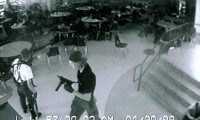Juno Reactor, “God is God” (1997)
Pairing Arabic-flavored techno with a Busby Berkeley number for schizophrenics, Juno Reactor’s “God is God” appears to be patched together from silent Armenian films of the 1920s and artfully matched contemporary footage. The setting is a walled Middle Eastern city, whose inhabitants pass the time performing repetitive, stylized, and mostly purposeless actions. Whatever they do, they seem to do unchangingly, forever, the way people do things in hell. No one looks like he’s suffering much, but nobody’s enjoying himself either.
The footage is either in sepia or washed-out color. In almost every shot the performers are arranged laterally in the space and move only from side to side. Almost everyone stares fixedly ahead, with the walled-off gaze of schizophrenia, so that when the male and female leads—the only people in the video recognizable as actors — look directly at you, bolts seems to shoot from their eyes. It’s like one of those dreams in which the dreamer is only a spectator until one of his characters suddenly notes his presence and addresses him.
The video’s overstuffed tableaus and radical juxtapositions come out of the Surrealist playbook, as do the impassive faces of the performers, but there’s Expressionism here, as well. The membrane between what is inside and what is outside has been rent. Everything is charged with some nameless feeling. Maybe it’s anxiety — I’d be anxious, too, if a bodiless voice were telling me “You shall see good and Ee-vil.” Maybe it’s fury or a grave, unsmiling joy.
The architecture is the architecture of the subconscious, turreted, many-chambered, with faded frescoes on its ceilings and manholes that quiver slightly as men vanish down them, so that you half-expect them to lick their lips afterward. The only thing missing is shadows.
For those, you have to go to some earlier and purer artifacts of Expressionism, like Paul Wegener’s 1920 “The Golem.” Here, too, there’s a city, Prague. More than any other film genre, Expressionism is urban, like its sharp-dressing, wised-up offspring, Noir.
In cities people live packed together, like the throng seen filing to shul from an upstairs window. Closeness forces them to suppress parts of themselves; otherwise, they might kill each other. Yet all those discarded fragments of personality and desire keep coming back to invade any and every available space, and take possession of it.
Paul Wegener, “The Golem” (1920)
Buildings bend toward their neighbors as if whispering secrets. The tower in which much of the action takes place seems to be a cross-section of the inner ear. It’s not just architecture that’s animated this way. Every face in the film is contested by many feelings at once. Notice how quickly the expression of the young man pining at his sweetheart’s doorstep passes from bliss to suspicion to despair when he realizes that another man is in there with her. Check out his mouth. But his eyes are even more astonishing. If the performers in “God is God” never meet anybody’s gaze, the ones in “The Golem” look about them unceasingly, and their stares are boiling with meaning.
In silent movies, the performers’ eyes have to work overtime. Even the golem has the small hot eyes of a maddened boar (along with a hairpiece that is either a sheitel—the wig worn by Orthodox women — or half a pumpkin shell). His eyes are where the life in him dwells, and when he’s deactivated they close once more.
Eyes also figure in “The Cabinet of Dr. Caligari” — fittingly, since the doctor is a hypnotist — though, really, the most arresting gaze is that of Cesare the Somnambulist, who sees the future.
Robert Wiene, “The Cabinet of Dr. Caligari” (1920)
– Peter Trachtenberg







